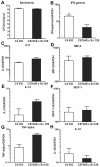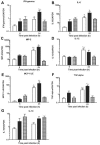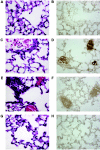Modulation of the lung inflammatory response to serotype 8 pneumococcal infection by a human immunoglobulin m monoclonal antibody to serotype 8 capsular polysaccharide
- PMID: 16040964
- PMCID: PMC1201218
- DOI: 10.1128/IAI.73.8.4530-4538.2005
Modulation of the lung inflammatory response to serotype 8 pneumococcal infection by a human immunoglobulin m monoclonal antibody to serotype 8 capsular polysaccharide
Abstract
The human monoclonal antibody to serotype 8 pneumococcal capsular polysaccharide D11 [immunoglobulin M(kappa)] protects wild-type and complement component 4 knockout (C4 KO) mice against lethal intratracheal challenge with serotype 8 pneumococcus, but it does not promote polymorphonuclear leukocyte (PMN)-mediated pneumococcal killing in vitro. In this study, we investigated the effect of D11 on the blood and lung bacterial burdens and the serum and lung expression of inflammatory chemokines and cytokines in an intratracheal challenge model with serotype 8 pneumococcus in C4 KO mice. Pneumococcus was not detected in the blood of D11-treated mice, whereas control mice had high-grade bacteremia with >10(7) CFU. Control mice had a >5-log increase in lung CFU and D11-treated mice manifested a nearly 3-log increase in lung CFU compared to the original inoculum 24 h after infection. Serum and lung levels of soluble macrophage inflammatory protein 2 (MIP-2) and interleulin-6 (IL-6) as measured by an enzyme-linked immunosorbent assay were lower in D11-treated mice than in control mice 24 h after infection. Real-time PCR was performed to examine lung mRNA chemokine and cytokine expression. The results showed that D11-treated mice had significantly less gamma interferon, MIP-2, IL-12, monocyte chemoattractant protein 1/JE, and tumor necrosis factor alpha expression than control mice 24 h after infection. Histopathology and immunohistochemical staining of lung tissues revealed that D11-treated mice had less inflammation, fewer PMNs, and less myeloperoxidase staining than control mice 24 h after infection. These findings suggest that the efficacy of certain serotype-specific antibodies against pneumococcal pneumonia could be associated with modulation of the lung inflammatory response and a reduction in host damage.
Figures





Similar articles
-
A serotype 3 pneumococcal capsular polysaccharide-specific monoclonal antibody requires Fcγ receptor III and macrophages to mediate protection against pneumococcal pneumonia in mice.Infect Immun. 2012 Apr;80(4):1314-22. doi: 10.1128/IAI.06081-11. Epub 2012 Jan 30. Infect Immun. 2012. PMID: 22290146 Free PMC article.
-
Modulation of polymorphonuclear cell interleukin-8 secretion by human monoclonal antibodies to type 8 pneumococcal capsular polysaccharide.Infect Immun. 2003 Dec;71(12):6775-83. doi: 10.1128/IAI.71.12.6775-6783.2003. Infect Immun. 2003. PMID: 14638763 Free PMC article.
-
Molecular and functional characteristics of a protective human monoclonal antibody to serotype 8 Streptococcus pneumoniae capsular polysaccharide.Infect Immun. 1999 Aug;67(8):4119-27. doi: 10.1128/IAI.67.8.4119-4127.1999. Infect Immun. 1999. PMID: 10417182 Free PMC article.
-
Isolation and Characterization of Human Monoclonal Antibodies to Pneumococcal Capsular Polysaccharide 3.Microbiol Spectr. 2021 Dec 22;9(3):e0144621. doi: 10.1128/Spectrum.01446-21. Epub 2021 Nov 10. Microbiol Spectr. 2021. PMID: 34756090 Free PMC article.
-
Influence of neutropenia on the course of serotype 8 pneumococcal pneumonia in mice.Infect Immun. 2007 Apr;75(4):1586-97. doi: 10.1128/IAI.01579-06. Epub 2007 Feb 12. Infect Immun. 2007. PMID: 17296760 Free PMC article.
Cited by
-
The Damage-Response Framework as a Tool for the Physician-Scientist to Understand the Pathogenesis of Infectious Diseases.J Infect Dis. 2018 Aug 14;218(suppl_1):S7-S11. doi: 10.1093/infdis/jiy083. J Infect Dis. 2018. PMID: 30124977 Free PMC article.
-
Diverse Mechanisms of Protective Anti-Pneumococcal Antibodies.Front Cell Infect Microbiol. 2022 Jan 28;12:824788. doi: 10.3389/fcimb.2022.824788. eCollection 2022. Front Cell Infect Microbiol. 2022. PMID: 35155281 Free PMC article. Review.
-
Unveiling Unexpected Immune Activities Induced by Your Pneumococcal Vaccine.mBio. 2016 Feb 23;7(1):e00137-16. doi: 10.1128/mBio.00137-16. mBio. 2016. PMID: 26908576 Free PMC article.
-
IgM in microbial infections: taken for granted?Immunol Lett. 2009 Aug 15;125(2):79-85. doi: 10.1016/j.imlet.2009.06.003. Epub 2009 Jun 17. Immunol Lett. 2009. PMID: 19539648 Free PMC article. Review.
-
Extracellular Adenosine Protects against Streptococcus pneumoniae Lung Infection by Regulating Pulmonary Neutrophil Recruitment.PLoS Pathog. 2015 Aug 27;11(8):e1005126. doi: 10.1371/journal.ppat.1005126. eCollection 2015 Aug. PLoS Pathog. 2015. PMID: 26313746 Free PMC article.
References
-
- Ali, F., M. E. Lee, F. Iannelli, G. Pozzi, T. J. Mitchell, R. C. Read, and D. H. Dockrell. 2003. Streptococcus pneumoniae-associated human macrophage apoptosis after bacterial internalization via complement and Fcgamma receptors correlates with intracellular bacterial load. J. Infect. Dis. 188:1119-1131. - PubMed
-
- Arva, E., and B. Andersson. 1999. Induction of phagocyte-stimulating and Th1-promoting cytokines by in vitro stimulation of human peripheral blood mononuclear cells with Streptococcus pneumoniae. Scan. J. Immunol. 49:417-423. - PubMed
-
- Austrian, R., R. M. Douglas, G. Schiffman, A. M. Coetzee, H. J. Koornhof, S. Hayden-Smith, and R. D. Reid. 1976. Prevention of pneumococcal pneumonia by vaccination. Trans. Assoc. Am. Physicians 89:184-194. - PubMed
Publication types
MeSH terms
Substances
Grants and funding
LinkOut - more resources
Full Text Sources
Other Literature Sources
Research Materials
Miscellaneous

